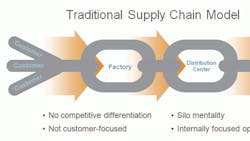Value Stream Segmentation Focuses on Customer Needs
Velocity and flexibility have been supply chain management buzzwords for decades. These objectives have prompted companies to invest billions of dollars into new information technology, supplier development programs and redesigned distribution networks. Much of that effort has been a waste of time and money. Let me explain.
In a traditional manufacturing business, the sales department always wants more inventory. Suppliers want larger orders. And operations wants longer production runs. Driven by economies of scale thinking, each of these functional biases ultimately reduces velocity and flexibility and increases costs. Customers still want their orders delivered tomorrow, or sooner, but too often the specific items or configurations that they want are out of stock and put on back order, or the sale is simply lost.
At some point the call goes out from the corporate office: Our supply chain must be revamped and optimized to increase velocity and flexibility. New IT systems are then rolled out to increase material and order visibility. Manufacturing processes are leaned out; tripling inventory turns and reducing order lead times from a month to a week or less. The supplier base is rationalized and partnerships are formed with key vendors. Distribution networks are restructured. And, lo and behold, material and goods flow faster, and orders are delivered in half the time. And then competitors follow suit.
So the supply chain must become even faster and even more flexible. More investments are made, suppliers' arms are twisted, production operations are expedited even further, and... I think you get the picture. Unfortunately, a very important player is overlooked in this one-size-fits-all supply chain optimization strategy: your customers.
Connecting customer demand, market strategy and execution
True customer focus starts from a value stream segmentation perspective. The idea that you should organize your businesses around value streams has been promoted for years, but the vast majority of companies still approach production planning, manufacturing and order fulfillment -- again, driven by economy of scale and cost-based thinking -- in ways that treat all customers the same.
There are a variety of reasons why a business should not serve all of its customers with the same order-fulfillment strategy.
From the customer's perspective:
• Customer service Strategic customers deserve and expect concierge-level service.
• Service requirements Different customer segments have different product option needs and value-added service requirements.
• Innovation and new products New products and features developed for one market segment may have little interest or appeal for another.
From a business perspective:
• Profitability Knowledge of long-term sales and earnings potential should influence order fulfillment commitments.
• Cost control Order-fulfillment models should match customer expectations. Faster service, for example, could be offered at a premium for customers willing to pay for it.
• Sales growth Tighter alignment between customer expectations and order fulfillment performance will improve the customer experience for both premium- and value-oriented customers, improving profitability and revenue growth.
One Size Does Not Fit All
Value stream segmentation starts with understanding actual customer requirements through demand segmentation. By analyzing and segmenting customer requirements, your businesses can optimize individual value streams to match the unique needs of those customers. A demand segmentation initiative will look at order volumes, order variability, historic inventory levels, shipment records and point-of-sale data. In the factory this analysis can be used to determine if a product should be made using a "pull" system, or if it should only be produced on a made-to-order basis. It should also influence supply chain strategies.
For example, PC manufacturers in various markets around the world have attempted to perfect a mass-customization business model in order to offer an almost infinite variety of product configurations based on each customer's unique needs. What they're discovering is that a significant percentage of customers don't require such extreme customization. Retail outlet buyers, for example, are perfectly happy with a fairly standard configuration with the possibility perhaps of a few minor modifications. The mass customization fulfillment model does not match the value stream requirements of those customers.
"Inventory reductions and service level improvements will typically deliver sufficient cost savings to justify a value stream approach."
Ken Koenemann is managing director of TBM Consulting Group, Inc. He helps clients leverage lean into the extended enterprise -- applying lean principles to their sourcing, manufacturing, warehousing, distribution, planning and scheduling processes. He was trained by two original members of Taiichi Ohno's Autonomous Study Group and spent six months in Japan learning and implementing the Toyota Production System.
| Definitions Value Stream Management: A strategic approach for organizational alignment and structure that ensures all functions are aligned to support specific value streams or strategic lines of business. A value stream manager has profit & loss responsibility for a segment and generally manages direct reports or a matrix organization aligned to effectively run the business. Value Stream Segmentation: A strategic process for analyzing and understanding different customer requirements within a value stream that helps organizations to define and implement product features, service offerings and customer interfaces aligned to customer expectations. Demand Segmentation: An analytical approach to understanding customer buying patterns through the analysis of volume, variability and frequency to determine product portfolio needs, optimize sourcing, manufacturing and distribution decisions and select appropriate fulfillment and management systems. Supply Chain Segmentation: An approach for grouping customers with similar fulfillment needs and then developing distinct supply chain operations to meet those particular requirements. The objective of segmentation is to develop distinct supply chains that are able to more efficiently and profitably meet a wide range of customer needs. |
